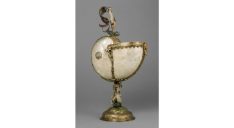Venus-Fortuna
In the cup’s design, the central shell is framed by two female figures: the sculpture of a female nude sailing in a shell boat on top, and a mermaid below the nautilus conch. Figures who resemble the ones in Kornblum’s cup include Fortuna, the allegorical personification of luck and Roman goddess of Fortune, who was often depicted standing or flying on an orb that could be positioned inside a shell.
Venus, the goddess of Love, could be represented in similar ways. When represented on board of shell-like ships, both Fortuna and Venus symbolically refer to the activity of sailing the ocean of love and navigating across its potentially stormy waves.
In this cup the Venus/Fortuna-like figure on top is counterbalanced by another female figure commonly associated with the ocean in early modern art and design: a mermaid. Wearing a crown and precious jewelry, this queen of mermaids is supported by an object stand incised with images of sea creatures and waves.
Both females link the nautilus shell to faraway spaces; on the one hand the mythological realms that Venus and Fortuna inhabit, and on the other foreign shores that could only be reached on board of ships crossing oceans populated by mermaids.
](https://micrio.thingsthattalk.net/XnBVe/views/max/128x128.jpg)
](https://micrio.thingsthattalk.net/GVihP/views/max/128x128.jpg)
](https://micrio.thingsthattalk.net/JmLIQ/views/max/305x128.jpg)
](https://micrio.thingsthattalk.net/ukvJV/views/max/305x128.jpg)
